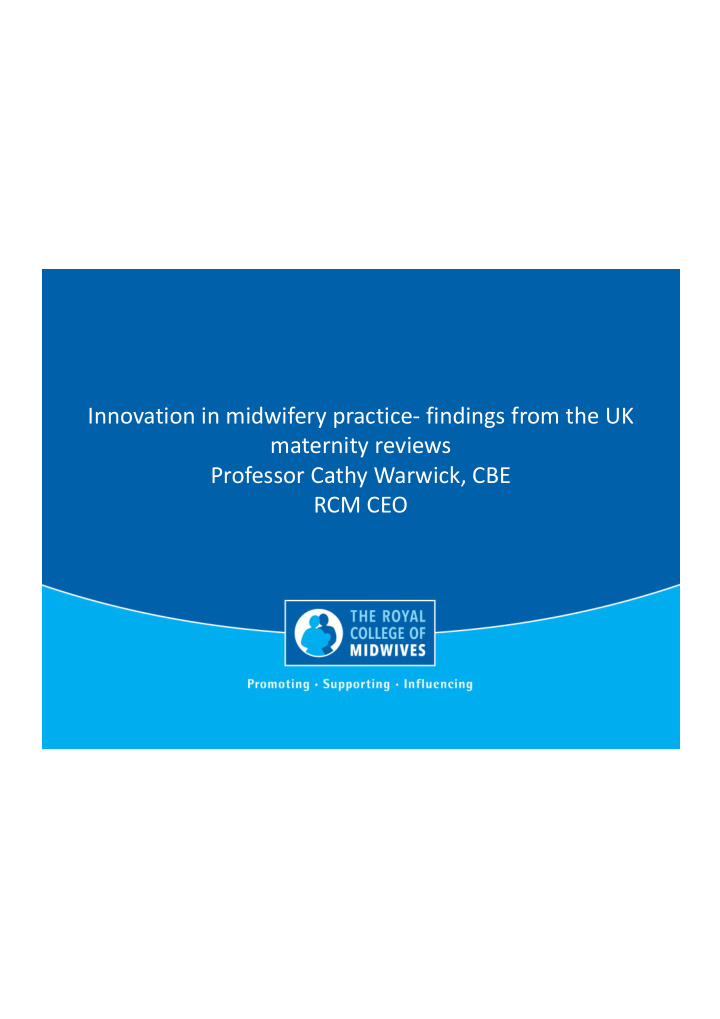



Innovation in midwifery practice- findings from the UK maternity reviews Professor Cathy Warwick, CBE RCM CEO
A new vision? 2 Our vision for maternity services across England is for them to become safer, more personalised, kinder, professional and more family friendly; where every woman has access to information to enable her to make decisions about her care; and where she and her baby can access support that is centred around their individual needs and circumstances. And for all staff to be supported to deliver care which is woman centred, working in high performing teams, in organisations which are well led and in cultures which promote innovation, continuous learning and breakdown organisational and cultural boundaries. The Royal College of Midwives | www.rcm.org.uk
Better Births 3 • Personalised care • Continuity of carer • Safer care • Better postnatal and perinatal mental health care • Multi-professional working • Working across boundaries • A fair payment system The Royal College of Midwives | www.rcm.org.uk
The workforce is doing well 4 ‘The NHS is a safe place to give birth. Maternity services in England are safe and high quality, and outcomes are improving. The stillbirth and neonatal mortality rates fell by 12% and 10% respectively between 2010 and 2015 The majority of women have a positive experience of childbirth and good outcomes.’ DH: Safer Maternity Care Next steps towards the national maternity ambition Oct 2016 The Royal College of Midwives | www.rcm.org.uk
But in terms of safety of babies 5 • Even one stillbirth or neonatal death is a tragedy • The Lancet Stillbirth Series 2016 ranked UK 24 th out of 49 high income countries • We reduce our rate by 1.4%. The Netherlands achieves 6.8% • We know that half of all term, singleton, without a congenital abnormality who die have at least one element of their care that could have been improved and may have made a difference to the outcome • There are documented internal reviews into only one quarter of these deaths • There are unexplained variations between areas even after adjusting for the effects of maternal age and deprivation The Royal College of Midwives | www.rcm.org.uk
Could it happen here? 6 The Royal College of Midwives | www.rcm.org.uk
And in addition 7 • outcomes for mothers are very varied eg in women having their first baby by instrumental delivery the chance of them having a significant perineal tear ranges from 3% to 11%. • almost half of CQC inspections result in safety assessments that are either inadequate (7%) or requires improvement (41%) • women are meant to be offered choice of place of birth but in the 2015 CQC maternity survey 16% of women got no choice and 25% of women did not get the widest possible choice • Maternity services staff report very high levels of stress compared to other staff groups The Royal College of Midwives | www.rcm.org.uk
Better Births Vision 8 Continuity of Care: Continuity of Care: to ensure safe care based on a relationship of mutual trust and respect in line with the woman’s decision woman’s decision The Royal College of Midwives | www.rcm.org.uk
What is it? 9 • A midwife who will normally provide continuity throughout a woman’s journey, if that is what she and her partner want • The midwife will usually work in and be supported by a small team of four to six midwives, one of whom could be a buddy and take responsibility for the woman’s care if her midwife is not available • Each team of midwives should have an identified obstetrician who can get to know and understand their service and can advise on issues as appropriate • Having a midwife the woman knows at the birth. Ideally this will be her own midwife, but if that is not possible, a midwife from the same team of four to six • Where a woman needs on-going obstetric support, this should be from a single obstetric team and the care should be fully integrated across the midwifery and obstetric services The Royal College of Midwives | www.rcm.org.uk
Implementing Continuity 10 • A strategic plan is essential: including how we educate students • Innovation and flexibility are essential too: very different models are being encouraged • Midwifery numbers must be sufficient • Recruitment and retention • Audit • Start to improve • Antenatal/postnatal, move on to labour • Small teams – possibly for women most disadvantaged • Review as information emerges The Royal College of Midwives | www.rcm.org.uk
Better Births 11 • Focus on leadership: create strong leadership for maternity systems at every level • Focus on learning and best practice: identify and share best practice and learn from investigations • Focus on teams: prioritise and invest in the capability and skills of the maternity workforce and promote effective multi- professional team working • Focus on data: improve data collection and linkages between maternity and other clinical data sets , to enable benchmarking and drive a continuous focus on prevention and quality • Focus on innovation: create space for accelerated improvement and innovation at local level. The Royal College of Midwives | www.rcm.org.uk
Personalised Care 12 The Royal College of Midwives | www.rcm.org.uk
Choice 13 The Royal College of Midwives | www.rcm.org.uk
For further information Website: www.rcm.org.uk Telephone: 0300 303 0444 Email: info@rcm.org.uk www.facebook.com/midwivesRCM @MidwivesRCM
Recommend
More recommend